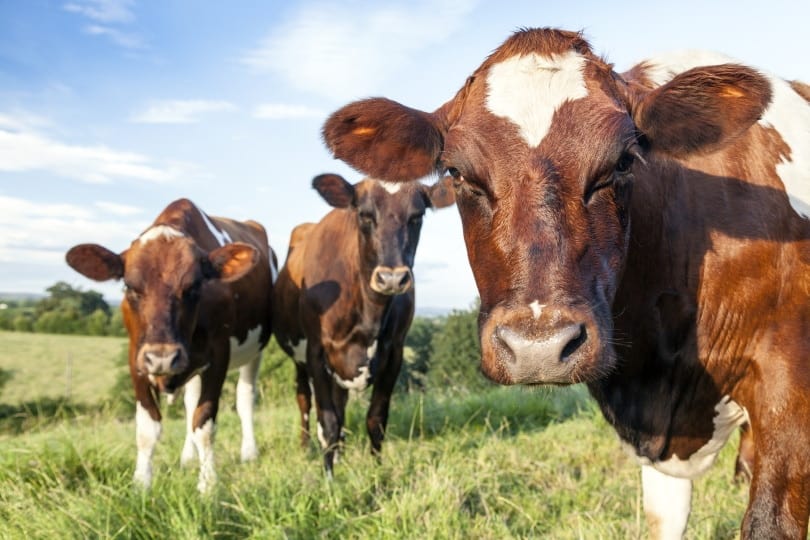Like many livestock breeds, the Ayrshire cattle is one of European origins. It is the only breed of dairy cow that was “developed” on the main isles of Britain, rather than on surrounding islands, but its origin stems from Scotland. It’s highly prized for its excellent milk production, especially in comparison to its medium size.
If you are looking for an easy-care, great milk producer addition to your land, then the Ayrshire Cattle may suit you perfectly. Read on to learn more about them!

Quick Facts about Ayrshire Cattle
| Breed Name: | Ayrshire Cattle |
| Place of Origin: | Scotland |
| Uses: | Diary production |
| Bull (Male) Size: | 450-600kg |
| Cow (Female) Size: | 450-600kg |
| Color: | Red and white |
| Lifespan: | 15-20 years |
| Climate Tolerance: | Hardy |
| Care Level: | Relatively easy |
| Milk Production: | Very good |
| Horned: | Yes |
Ayrshire Cattle Origins
Ayrshire Cattle originally date back as far as 1750, where they were crossbred from other breeds of cattle to produce their distinctive red/brown spots. The exact ancestral breeds are not known. They received their namesake from their county of origin in Scotland, Ayrshire.
They cycled through a few different names during the development as a breed, including Dunlop and Cunningham, before settling on something more traditional. In 1814, Ayrshire Cattle were officially recognized by the Highland Agricultural society.
Not long after, in 1822, Ayrshire Cattle were brought to the United States, where they still reside, and the American Ayrshire Breed Association was formed in 1875.

Ayrshire Cattle Characteristics
Ayrshire Cattle has persisted as a prevalent choice of diary cow even in modern times due to their hardiness. They are tolerant to varying climates and generally have good health. They also have excellent lifespans of 15-20 years and have low rates of calving issues.
These tolerant and tough traits are thought to have emerged as adaptions to the wild habitat they originated from in lowland Scotland. Over time they evolved and were bred to survive in inclement conditions, making them robust cattle in modern times.
In addition to this vigor and resilience, they are considered efficient grazers. Simply put, the milk output is superior to other dairy cattle in reflection of their feed input. They are also noted to have fantastic udders that are loved for their shape and quality.
In terms of temperament, Ayrshire Cattle are well-behaved and docile. In a herd of mixed breed cattle, they are the least likely to be picked on due to their agreeability. They are also resilient to herd change, which many cows can be sensitive to, often affecting milk supply.

Uses
Ayrshire Cattle are mostly raised and kept for milk production. Their production for a medium-sized cow is very good, and a single cow can produce 20,000 pounds of milk in a year. Their milk is described as the “ideal drinking milk.” It is flavorsome but not overly rich and has the right kinds of fat and protein level that make it perfect for producing cheese and butter.
In addition, Ayrshire bull calves are raised as steers for meat production. Older dairy heifers that are no longer efficient can also make for good eating.
Appearance & Varieties
Ayrshire Cattle are exclusively red and white. The red will range from light tone to very dark browns that can be confused as black from a distance, especially in contrast to the white.
Markings of red and white vary greatly, with some cows having much more white and others having much more red. Ayrshire Cattle are distinctive in the shape of their markings, with spots being jagged and irregular. The U.S Ayrshire Association has no restriction on patterns in their registrations.
Ayrshire Cattle is considered medium-sized; even so, an average-sized Ayrshire weighs in at a whopping 1,200lb when fully mature.
A less known distinctive feature is the horns of the Ayrshire. During their history, their long horns were their distinguishing feature. Nowadays, calves are dehorned. This is for ease of care as it reduces the risk of injury to farmers and reduces the risk of growth complications. If not docked, horns can reach up to 12 inches.

Population/Distribution/Habitat
In most habitats, Ayrshire Cattle are comfortable, granted they have enough feed and space. Having originated in lowland Scotland, they are well adapted to many habitats. They are resilient to poor fertility and low feed.
Ayrshire Cattle are distributed across the whole farming world. United States populations have heavily declined in the last few decades as the Ayrshire is not suited for the confined farming that is emerging with high land demand. The Livestock Conservancy has recently classified Ayrshire Cattle as “recovering” due to the current interest in heritage breeds and livestock conservation.
Ayrshires are popular in countries with high dairy exports, such as Australia and New Zealand.


Are Ayrshire Cattle Good for Small-Scale Farming?
On a smaller scale, Ayrshire Cattle is a great choice for small milk production. This breeds resilience and demeanor makes them good options for “farm-lets” or lifestyle blocks. They will efficiently produce milk in smaller areas and less feed than other dairy cattle.
Their milk production can help to feed a self-sufficient family or homesteading hobbyists. To make a profit on a small scale will depend on the quality of your land and your ability to connect with a selling market. Producing dairy products from the milk yield would be the most profitable choice on a small scale.
If you are looking for a resilient and high-producing dairy cow for your small-scale farm, then you have likely found your perfect match in the Ayrshire Cattle!
Featured Image Credit: one pony, Shutterstock
